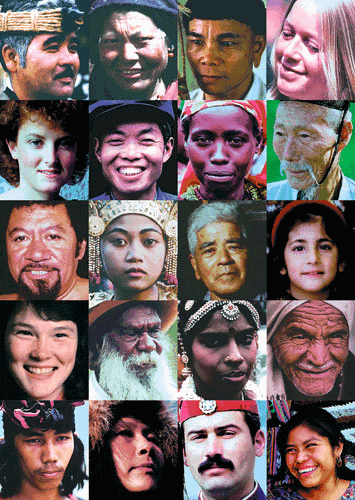
How Did the Different Races of Men Arise From Noah and His Family?
|
|
| A few members of the human race from the following places: top row, left to right: Japan, Tibet, Borneo, Holland; second row: Ireland, China, Rwanda, Korea; third row: New Zealand, Bali, Okinawa, Israel; fourth row: United States of America, Australia, India, Egypt; bottom row: Molucca Islands, Canada, Greece, Guatemala. Visualize all without variations in dress, hair style, age, and skin color. |
How different are we? People continents apart laugh alike and cry alike. Our differences are small; the ways we are the same are great.
(Walt Brown, In the Beginning, p.271)
How the Different Races of Men Arise From Noah and His Family
Note: The following information was gleaned from the Answers in Genesis web site dealing with this issue:
• According to the Bible, all humans on earth today are descended from Noah and his wife, his three sons and their wives and before that from Adam and Eve.
– Acts 17:26 - From one man [literally, “one blood”] He made every nation of men, that they should inhabit the whole earth; and He determined the times set for them and the exact places where they should live.
• Therefore, in one sense, there is really only one race: the human race!
• But today we have many different groups, often called ‘races,’ with what seem to be greatly differing features. The most obvious of these is skin color.
• Many see this as a reason to doubt the Bible’s record of history. They believe that the various groups could have arisen only by evolving separately over tens of thousands of years.
• However, as we shall see, this does not follow from the biological evidence.
• The Bible tells us how the population that descended from Noah’s family had one language and by living in one place were disobeying God’s command to ‘fill the earth’ (Genesis 9:1, 11:4).
• God confused their language, causing a break-up of the population into smaller groups which scattered over the earth (Genesis 11:8-9).
• Modern genetics show how, following such a break-up of a population, variations in skin color, for example, can develop in only a few generations.
• There is good evidence that the various people groups we have today have not been separated for huge periods of time
• The Bible does not speak of races per se; it speaks instead of tribes, people groups, languages and nations.
– Revelation 13:7 - He was given authority over every tribe, people, language and nation.
• Clearly, though, there are groups of people who have certain features (e.g., skin color) in common, which distinguish them from other groups.
• We prefer to call these ‘people groups’ rather than ‘races,’ to avoid the evolutionary connotations associated with the word ‘race.’
• All peoples can interbreed and produce fertile offspring.
• This shows that the biological differences between the ‘races’ are not very great. In fact, the DNA differences are trivial.
• The DNA of any two people in the world would typically differ by just 0.2 percent.2
• Of this, only 6 percent can be linked to racial categories; the rest is ‘within race’ variation.
• Virtually all evolutionists would now say that the various people groups did not have separate origins. That is, different people groups did not each evolve from a different group of animals.
• So they would agree with the biblical creationist that all people groups have come from the same original population.
• Many people believe that the observable differences between “races” arise from some people having unique features in their hereditary make-up which others lack.
• This is an understandable but incorrect idea. Let’s look at skin color, for instance.
• We all have the same coloring pigment in our skin—melanin.
• This is a dark-brownish pigment that is produced in different amounts in special cells in our skin.
• If we had none (as do people called albinos, who inherit a mutation-caused defect, and cannot produce melanin), then we would have a very white or pink skin coloring.
• If we produced a little melanin, we would be European white.
• If our skin produced a great deal of melanin, we would be a very dark black.
• And in between, of course, are all shades of brown. There are no other significant skin pigments
• How is it that many different skin colors can arise in a short time?
• Remember, whenever we speak of different ‘colors’ we are referring to different shades of the one color, melanin.
• If a person from a very black people group marries someone from a very white group, their offspring (called mulattos) are mid-brown.
• It has long been known that when mulattos marry each other, their offspring may be virtually any ‘color,’ ranging from very dark to very light.
• Understanding this gives us the clues we need to answer our question, but first we must look, in a simple way, at some of the basic principles of heredity.
• We know that skin color is governed by more than one pair of genes.
• For simplicity, let’s assume there are only two, located at positions A and B on the chromosomes.
– One form of the gene, ‘M,’ ‘says’ to make lots of melanin;
– Another form of the gene, ‘m,’ says to only make a little melanin.
• The number of ‘M’ versus ‘m’ forms of the gene that exist at each position would determine the skin color of the individual.
A ‘black’ gene combination
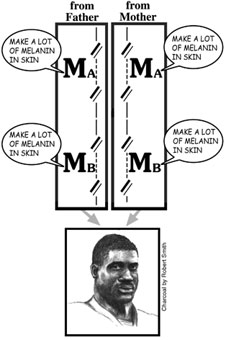 |
A ‘white’ gene combination
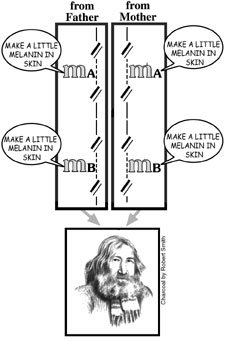 |
A ‘brown’ gene combination
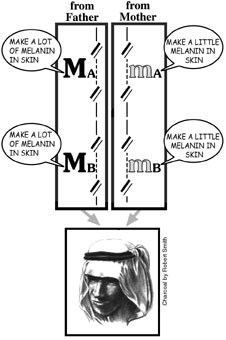 |
‘Punnet square’ showing the possible offspring from ‘mulatto’ brown parents.
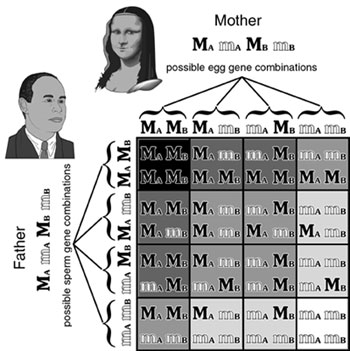 |
Examples of a Family With Mixed Skin Color
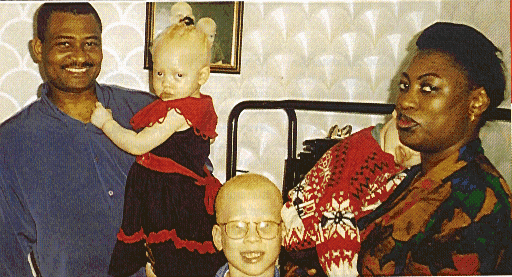 |
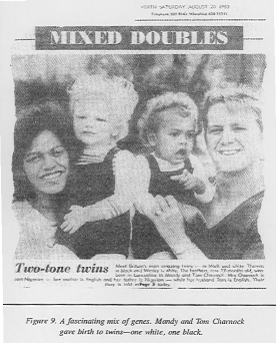 |
• Noah and his family were probably mid-brown, with genes for both dark and light skin, because a medium skin color would seem to be the most generally suitable (dark enough to protect against skin cancer, yet light enough to allow vitamin D production).
• As all the factors for skin color were present in Adam and Eve, they would most likely have been mid-brown as well, with brown eyes and brown (or black) hair.
• In fact, most of the world’s population today is still mid-brown.
• After the Flood, for the few centuries until Babel, there was only one language and one culture group.
• Assuming there were no barriers to marriage within this group, this would tend to keep the skin color of the population away from the extremes.
• To produce a change in skin color, you would need to break a large breeding group into smaller groups and keep them separate, that is, prevent interbreeding between groups. This would be true for animal as well as human populations, as every biologist knows.
• This is exactly what happened at Babel. Once separate languages were imposed, there were instantaneous barriers. Entire groups which spoke the same language would have difficulty relating to and trusting those which did not.
• Thus, they would move away or be forced away from each other, into different environments. This, of course, is what God intended.
• It is unlikely that each small group would carry the same broad range of skin colors as the original, larger group.
• One group might have more dark genes, on average, while another might have more light genes.
• The same thing would occur with other characteristics: nose shape, eye shape, etc.
• And since they would intermarry only within their own language group, these differences would no longer be averaged out as before.
• The dispersion at Babel broke up a large interbreeding group into small, inbreeding groups.
• This ensured that the resultant groups would have different mixes of genes for various physical features.
• By itself, this dispersion would ensure, in a short time, that there would be certain fixed differences in some of these groups, commonly called ‘races.’
• In addition, the selection pressure of the environment would modify the existing combinations of genes so that the physical characteristics of each group would tend to suit their environment.
• For the past 140 years, evolution has painted a very different picture from the Biblical view.
• According to the original theory, man supposedly ascended from some apelike ancestor and because some early humans branched off sooner than others, they had different physical, mental, and behavioral characteristics.
• This is racism, a highly prejudicial school of thought that dehumanizes fellow human beings.
• One cannot say that evolutionists today are racists, although Charles Darwin and many of his followers were.
• Racism is unpopular today, at least openly, so public acknowledgment of it is rare. However, the theory of evolution provides a rationale to justify racism.
• Genesis provides quite a different historical perspective. We are all descended from Adam and Eve and from Noah and his wife. Consequently, we are all cousins. Think what the world would be like if everyone realized that and acted accordingly !